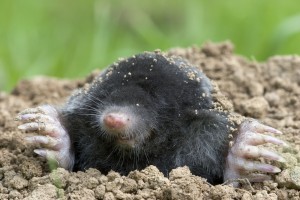by Eric Gibson
 Have you ever walked your yard and almost broken your neck because the turf you were stepping on caved? If so, you’ve most likely stepped on a mole runway. But before you start rolling out the hose to take care of this critter “Caddyshack style,” you may want to read on and familiarize yourself more with the creature that can actually be beneficial to your yard.
Have you ever walked your yard and almost broken your neck because the turf you were stepping on caved? If so, you’ve most likely stepped on a mole runway. But before you start rolling out the hose to take care of this critter “Caddyshack style,” you may want to read on and familiarize yourself more with the creature that can actually be beneficial to your yard.
Moles aren’t rodents. They aren’t on the same diet plan as rats and mice. Moles are insect eating mammals. Other animals of this sort include hedgehogs and shrews, but, unlike their ancestors, moles live mostly underground. They are nature’s most gifted burrowers.
Moles have large, powerful front feet with which to push the soil around. They are 5 1/2 to 6 inches long and have a bald tail 1 to 1 1/2 inches long. They have soft fur that doesn’t project towards the tail so that if they are tunneling forward or backward, the soil doesn’t get trapped under their coat. Their fur is slate gray with a velvety sheen. The most common species are the Eastern mole and the star-nosed mole. The latter has finger-like projections that protrude from the nose. I will be discussing the more common Eastern Mole.
 Habitat and Food
Habitat and Food
The Eastern Mole prefers loose, well-drained soils. Moles dislike tunneling through mud. Moles will strategically tunnel around plant roots, looking for earthworms and insects to eat. In this way, moles are beneficial and will eat the most common lawn pests: mole crickets, beetle larvae, ants, moth larvae, army worms and slugs. Because of a mole’s tunneling nature, they also aerate the soil, delivering more air to vegetation.
Fun Facts
Tunneling
- Moles can tunnel up to 18 ft per hour.
- They live in chambers 6 to 12 inches below the surface.
- A mole chamber is 4 to 6 inches in diameter.
Reproduction
Mole mothers have one litter a year, whereas 2 to 5 babies make up a litter. Moles mostly give birth in the month of March. Keep this in mind the next time you’re strolling your yard in the spring!
Damage and Control
In terms of damage to your yard, moles cause cosmetic damage ONLY. They don’t feed on the roots of plants, they simply eat around them. They are actually benefiting the plants by getting rid of the insects that actually do feed on the plants. If you are a home owner and bothered by the collapsed areas of your lawn and unsightly dirt piles, you can capture moles without a permit. Flooding tunnels can bring moles to the surface but not in sandy soils. You can also trap a mole using a homemade pitfall.
- Find an active tunnel by collapsing it and seeing if it’s reopened later. If it is, you’ve got a live mole runway.
- Sink a coffee can in the center of the runway as a pitfall and cover the surface with a board.
- The mole will hopefully fall into the coffee can the next time it is tunneling through the runway. Once you catch the mole, it can be released in a forested area.
Commercial mole traps are not the way to go because they impale the mole with spikes or choke them with choker loop. Pretty gruesome, eh?
You can take preventative measures against moles by controlling the populations of pest insects. Eliminating white grubs, mole crickets and soil insects will keep the moles away. To do this, you will need a professional lawn pest control technician. Instead of using pesticides, a good I.P.M. technician will use nematodes or other beneficial bacteria that are harmful to insects. Call Nozzle Nolen today for your free inspection!
Eric Gibson is the Director of Marketing at Nozzle Nolen, Inc., “King of the Bug Frontier,” serving Palm Beach County and the Treasure Coast for three generations. For more information about Nozzle Nolen, please visit www.nozzlenolen.com.
Nozzle Nolen is a member of the U.S. Green Building Council (USGBC). For more information about Nozzle Nolen and its Certified Green Solutions Program, visit www.nozzlenolen.com or call (800) 22-NOLEN.

